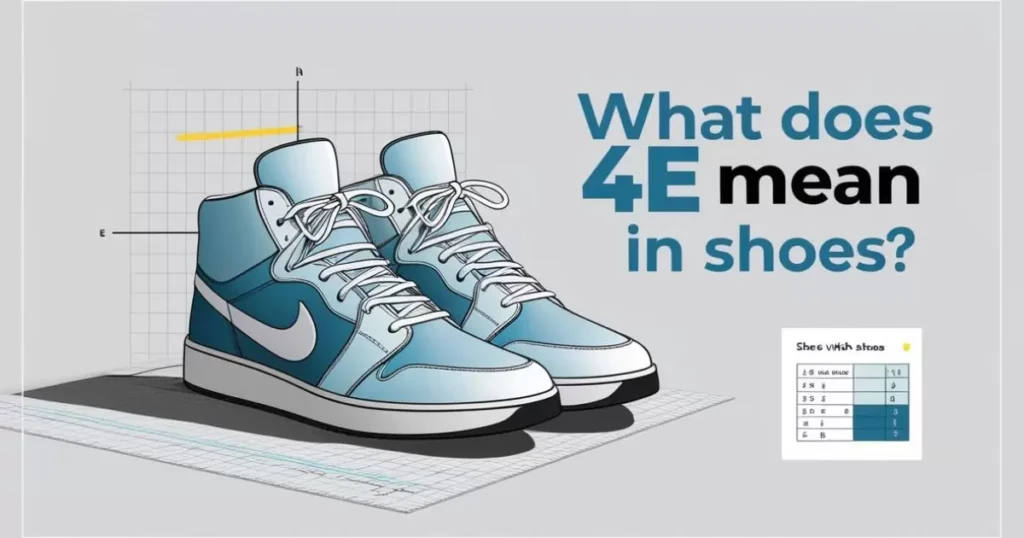Are you tired of squeezing your feet into shoes that feel like medieval torture devices? Do you find yourself longingly eyeing comfortable footwear, wondering if you’ll ever find a pair that fits just right? If you’ve ever encountered the term “4E” while shopping for shoes and scratched your head in confusion, you’re not alone. Let’s embark on a journey to decode the enigma of shoe widths, with a special focus on the roomy world of 4E footwear.
The ABCs of Shoe Width: More Than Just Length Matters
When it comes to shoes, size isn’t just about length. Width plays a crucial role in comfort and fit, yet it’s often overlooked. Let’s dive into the history of shoe width measurements and why they’re so important.
A Brief Walk Through History
The concept of shoe widths isn’t new. In fact, it dates back to the 1880s when manufacturers realized that feet come in various shapes and sizes. The Brannock Device, invented in the 1920s, revolutionized foot measurement by considering both length and width.
Why Width Matters as Much as Length
Imagine trying to fit a square peg into a round hole. That’s essentially what you’re doing when you force wide feet into narrow shoes. Here’s why width is crucial:
- Comfort: Proper width reduces pressure points and friction.
- Support: The right width ensures your foot is stable within the shoe.
- Health: Ill-fitting shoes can lead to bunions, blisters, and other foot issues.
- Performance: In athletic shoes, correct width can improve your performance.
Decoding the Alphabet Soup: From AAA to EEE
Shoe widths might seem like a secret code, but fear not! We’re about to crack it wide open.
Breaking Down Width Categories
Shoe widths typically range from AAA (narrowest) to EEE (widest). Here’s a quick rundown:
| Width | Women’s | Men’s |
| Narrow | AA, A | B, C |
| Medium | B, C | D |
| Wide | D | E |
| Extra Wide | E, EE | EE, EEE |
| Extra Extra Wide | – | 4E, 6E |
How Width Measurements Correspond to Letters
Each letter represents about 1/16 inch difference in width. So, moving from a D to an E width adds about 1/4 inch to the overall width of the shoe.
“Finding the right shoe width is like finding the perfect dance partner – when it’s right, everything just flows.” – Dr. Emily Splichal, Podiatrist and Human Movement Specialist
Spotlight on 4E: The Extra-Wide Comfort Zone

Now, let’s zoom in on our star of the show: 4E width.
Defining 4E Width
4E width is considered an extra-extra-wide size. It’s approximately 1/2 inch wider than a standard D width shoe. Picture a shoe that gives your toes the freedom to wiggle and spread naturally – that’s the 4E experience.
Who Typically Needs 4E Shoes?
4E shoes aren’t just for people with naturally wide feet. They’re also ideal for:
- Individuals with foot conditions like bunions or hammertoes
- People with diabetes who need extra room to accommodate swelling
- Those with orthotic inserts that require additional space
- Athletes whose feet tend to swell during intense activities
Common Foot Conditions That Benefit from 4E Width
- Bunions: These bony bumps at the base of the big toe need extra room.
- Edema: Swelling in the feet and ankles requires more space.
- Flat Feet: Wider shoes provide better support for fallen arches.
- Morton’s Neuroma: This painful condition between the toes benefits from a roomier toe box.
Comparing Widths: How 4E Stacks Up
To truly appreciate 4E width, let’s see how it compares to other widths.
Visual Comparison of Shoe Widths
Imagine three drinking straws side by side:
- 2E: A regular straw
- 3E: A milkshake straw
- 4E: A boba tea straw
The difference is noticeable, right? That’s similar to the progression in shoe widths.
Real-World Analogies to Understand Width Differences
- D width: Think of a standard envelope
- 2E width: A padded envelope
- 3E width: A small bubble mailer
- 4E width: A large bubble mailer
Each step up provides more cushioning and space, just like wider shoe widths.
The Hunt for the Perfect 4E Fit
Finding 4E shoes used to be like searching for a needle in a haystack. Thankfully, times have changed.
Top Brands Offering 4E Options

- New Balance: Known for their extensive range of widths
- Brooks: Offers 4E in many running shoe models
- Propét: Specializes in wide and extra-wide shoes
- Orthofeet: Focuses on orthopedic shoes with 4E options
- Dunham: Provides casual and dress shoes in 4E
Specialty Stores vs. Online Shopping for Wide Widths
Specialty Stores:
- Pros: In-person fitting, expert advice
- Cons: Limited inventory, potentially higher prices
Online Shopping:
- Pros: Vast selection, competitive prices, convenience
- Cons: Can’t try before buying, potential fit issues
Tips for Measuring Your Feet at Home
- Trace Your Foot: Stand on a piece of paper and trace your foot’s outline.
- Measure Length: Measure from heel to longest toe.
- Measure Width: Measure across the widest part of your foot.
- Do It Later: Feet swell throughout the day, so measure in the evening for the most accurate results.
- Use Both Feet: Your feet might be different sizes, so measure both and go with the larger size.
Beyond Width: Other Factors in Shoe Comfort
While width is crucial, it’s not the only factor in finding your perfect shoe soulmate.
Toe Box Shape and Depth
The toe box should mirror your foot’s natural shape:
- Round: Suits most foot types
- Square: Good for wide forefoots
- Pointed: Often problematic for wide feet, but some designs accommodate width
Arch Support Considerations
Your arch type affects the support you need:
- High Arches: Look for cushioning to absorb shock
- Normal Arches: Moderate support works well
- Flat Feet: Seek stability features and firm support
Material Flexibility and Breathability
- Leather: Molds to your foot over time, good breathability
- Mesh: Excellent for breathability, ideal for athletic shoes
- Synthetic Materials: Can be less breathable but often more durable and water-resistant
Breaking Myths About Wide Feet
Let’s bust some common misconceptions about wide feet and 4E shoes.
Debunking Common Misconceptions
- Myth: Wide feet are always flat feet. Truth: Foot width and arch height are separate characteristics.
- Myth: You can “break in” shoes to make them wider. Truth: While shoes may stretch slightly, it’s best to buy the correct width from the start.
- Myth: Wide shoes look bulky and unattractive. Truth: Many stylish options are available in wide widths, including 4E.
Embracing Foot Diversity
Everyone’s feet are unique, and that’s something to celebrate! Embracing your foot shape and finding shoes that truly fit can boost your confidence and comfort.
The Future of Wide Width Shoes
The world of wide width shoes is evolving rapidly, with exciting innovations on the horizon.
Innovations in Customizable Footwear
- Adjustable Width Systems: Some brands are developing shoes with expandable panels.
- Memory Foam Technologies: These adapt to your foot shape for a custom fit.
- Smart Shoes: Emerging tech allows shoes to adjust width based on foot swelling throughout the day.
3D Printing and Its Potential Impact
3D printing is revolutionizing the footwear industry:
- Custom Insoles: Perfectly matched to your foot’s contours
- Entire Shoes: Tailored to your exact measurements
- Rapid Prototyping: Allowing for quicker development of new wide-width designs
Caring for Your 4E Shoes
Proper care can extend the life of your 4E shoes and maintain their comfort.
Maintenance Tips to Prolong Shoe Life
- Rotate your shoes daily to allow them to dry and regain shape.
- Use shoe trees to maintain shape when not wearing.
- Clean according to material type (e.g., leather conditioner for leather shoes).
- Replace insoles regularly to maintain cushioning.
Stretching Techniques for a Perfect Fit
- Shoe Stretchers: Can provide minor width adjustments
- Professional Stretching: Cobblers can stretch shoes in specific areas
- Stretching Sprays: Can help soften leather for a more comfortable fit
When 4E Isn’t Enough: Exploring Custom Options
Sometimes, even 4E width doesn’t cut it. Here are some alternatives:
Bespoke Shoe Services
Custom-made shoes offer the ultimate in fit and comfort:
- Pros: Perfect fit, choice of materials and styles
- Cons: Higher cost, longer wait times
Orthopedic Solutions for Extremely Wide Feet
For medical-grade solutions:
- Custom Orthotics: Can improve fit in wider shoes
- Therapeutic Shoes: Designed for specific foot conditions
- Modifiable Shoes: Allow for adjustments by a podiatrist
FAQs: Your Burning Questions About 4E Shoes Answered
Q: Can I wear 4E shoes if I don’t have wide feet?
A: While it’s not recommended, some people prefer a roomier fit. However, too much width can lead to instability.
Q: Are 4E shoes only for men?
A: No, 4E width is available in women’s shoes too, though it may be less common.
Q: Will wearing 4E shoes make my feet look bigger?
A: Not necessarily. Well-designed 4E shoes can look proportional and stylish.
Q: How often should I measure my feet?
A: Annually is a good rule of thumb, as feet can change size over time.
Q: Can I use regular insoles in 4E shoes?
A: Yes, but you might need wider insoles to fill the extra space properly.
Conclusion: Stepping Confidently in Your 4E Shoes
Understanding what 4E means in shoes is crucial for anyone with wide feet or those seeking ultimate comfort in their footwear. As we’ve explored in this comprehensive guide, 4E represents an extra-extra-wide shoe width that provides ample room for those who need it. Decoding shoe widths isn’t just about letters and numbers; it’s about finding the perfect fit that supports your foot health and enhances your daily comfort.
Remember, your journey to comfortable shoes doesn’t end with knowing what 4E means in shoes. It’s about applying this knowledge to find the right pair for your unique feet. Whether you’re shopping online or in-store, armed with this information about shoe widths, you’re now equipped to make informed decisions. Don’t settle for shoes that pinch or squeeze – embrace the world of 4E and step into the comfort you deserve.

An author is a creator of written content, producing works ranging from books and articles to blog posts and essays. They use their creativity, knowledge, and research to inform, entertain, or persuade readers. Authors often have a unique voice and perspective, contributing significantly to literature and various media.

